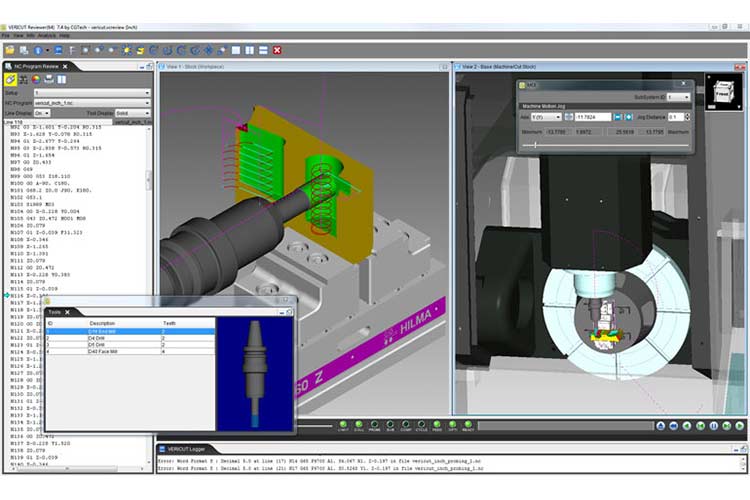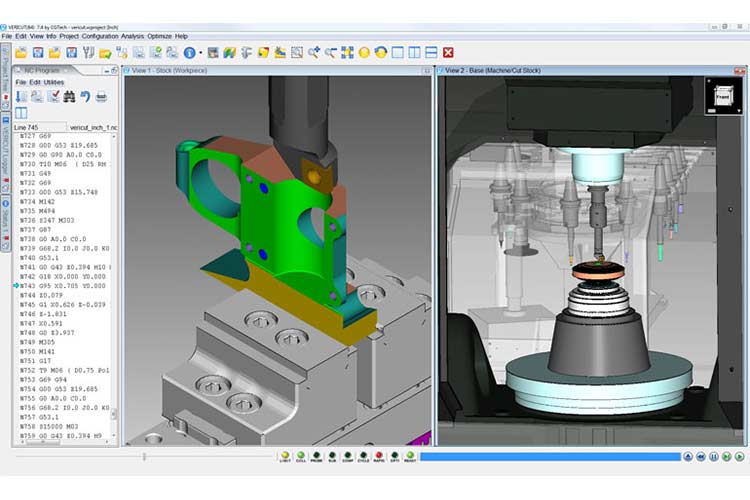In addition to new features designed to make NC programmers’ jobs easier, nearly 500 customer-driven enhancements and software change requests have been completed in version 7.4. These updates utilize the latest technologies to enable faster processing speeds, longer tool life and increased part quality. Added features to the user interface simplify the most common user actions and significant developer hours have been invested to increase simulation speed by more thoroughly taking advantage of multiple processors and background processing.
The enhancements in version 7.4 provide the speed that organizations need to rapidly release new part programs to the shop floor, train new users, and continually optimize workpiece quality. Changes to how users interact with VERICUT further improve workflow and simplify day-to-day NC programming and simulation use. VERICUT is constantly refined to provide the flexibility and tools you require. CGTech is committed to continually introducing technology to automate manual tasks and increase productivity and throughput.
Ease-of-use Enhancements
In version 7.4, the first change you will notice is a Welcome Screen that automatically displays when first launching a VERICUT session. The Welcome Screen provides access to commonly used first actions for a VERICUT session. The user interface continues to get more customizable. VERICUT’s desktop is enhanced with a new docking method enabling the desktop to be configured in the most efficient manner. The new docking method is very flexible and provides a high level of customization possibilities. Additionally, the Status window is completely redesigned for better viewing, customization and size. The Status window information is divided into Information Groups, each containing a specific list of information. The popular “Favorites” feature, added in version 7.3, has been enhanced to automatically read all sub-folders in a directory and a Favorites file can be opened by double clicking on it.

Tool Management Redesigned
Tool Manager’s desktop and user interface is redesigned to enable easier user interaction. A new Tool Bar located at the top of the Tool Manager window consists of a combination of icons and pull-down menus providing easy access to all features needed to create and maintain tool libraries, create/modify tool assemblies, import tool assemblies and create or import OptiPath records. Also, in the Tool List, tool components now have a Parent/Child hierarchy allowing for better tool assembly management and modification. All Tool Definition windows have been redesigned to make tool definition easier. VERICUT 7.4 ships with a library of common tools, making it quick and simple to add new tools to a simulation session.

More Powerful Reviewer
The Reviewer is enhanced with a new MDI option in the Analysis menu, enabling you to move machine axes interactively. This feature is available in both the Windows Reviewer and in the iPad Reviewer App. Additionally, a Tools window is added to the Analysis menu showing all tools used in the Reviewer files. Selecting a tool in the Tools window automatically sets the “Start” and “End” motion markers that are used to define the range of NC program records in the NC Program. Version 7.3 and later Reviewer files are now upward compatible.

Other New Features
- New interfaces are available for integrating VERICUT with Creo Parametric 3.0, CAMWorks, and SolidWorks. The GibbsCAM-to-VERICUT interface is redesigned. Interfaces are available to nearly every major CAM system and are updated with each release.
- Connect with Kennametal’s NOVO™, Iscar’s IQCloud™, and other tooling suppliers via the Machining Cloud™.
- Kuka Robot Language (KRL) is supported.
- OptiPath automatically works through multiple setups.
- NC program syntax is checked automatically when a file is opened.
New Module: Force™
Force is a physics and mathematics-based modeling software that optimizes machining rates for machined parts. Force determines the optimum speeds for a cutting process and makes the CNC machine cut in the most efficient, fast, and reliable way based on the type of material being cut. It is particularly suited to improve cutting tough materials — stainless steels, hardened alloy and tool steels, inconel, and titanium — which are commonly used in mold/die and aerospace parts. Once a material is characterized, it can be applied to a broad range of cutters and machines in future NC machining operations. Force is easy to set-up and can also predict tool wear.


